
38
Tạp chí phân tích Hóa, Lý và Sinh học - Tập 30, số 02/2024
MULTIVARIATE REGRESSION MODELS BASED ON UV FULL
SPECTRA FOR THE SIMULTANEOUS DETERMINATION OF
TETRACYCLINE, PENICILLIN G AND CEPHALEXIN IN DIFFERENT
DOSAGE FORMS
Đến tòa soạn 21-05-2024
Nguyen Duc Phong1, Nguyen Manh Son1, Nguyen Dieu Linh1, Nguyen Thi Minh Loi2,
Bui Xuan Thanh1, Pham Gia Bach1, Le Si Hung3, Ta Thi Thao1*
1. Faculty of Chemistry, VNU University of Science, Hanoi
2. Quang Binh Univerity
3. Thanglong instruments
*Email: tathithao@hus.edu.vn
TÓM TẮT
XÁC ĐỊNH ĐỒNG THỜI TETRACYCLINE, PENICILLIN G VÀ CEPHALEXIN
TRONG CÁC DẠNG BÀO CHẾ KHÁC NHAU BẰNG MÔ HÌNH HỒI QUY ĐA
BIẾN DỰA TRÊN PHỔ UV TOÀN PHẦN
Nghiên cứu này trình bày phương pháp phân tích nhanh, đơn giản và hiệu quả dựa trên dữ liệu quang phổ
UV toàn phần kết hợp với mô hình hồi qui tuyến tính đa biến đã được phát triển và xác nhận giá trị sử dụng
để xác định tetracycline (TET) penicillin G (PGP) và cephalexin (CEX) trong các dạng thuốc kháng sinh
viên nén, sử dụng nền mẫu giả dược (placebo) chứa các chất phân tích và nền mẫu thực có chứa một chất
phân tích và thêm 2 chất còn lại. Khoảng nồng độ tuyến tính của TET, PGP và CEX lần lượt là 12-28
μg/mL, 7-20 μg/mL và 5-18 μg/mL, với giá trị bước sóng cực đại lần lượt là 276 nm, 290 nm và 262 nm. Để
xác định đồng thời TET, PGP và CEX, mẫu thuốc được nghiền nhỏ, hòa tan trong nước cất 2 lần, rung siêu
âm và đo phổ UV của các chất phân tích trong khoảng từ 230 đến 350 nm với các khoảng Δλ = 2 nm ở 61
bước sóng. Bộ mẫu dùng để luyện mô hình gồm 31 mẫu chứa ba thành phần (cả mẫu thương mại chứa 1
chất và mẫu thêm chuẩn) và bộ mẫu kiểm tra gồm 9 mẫu đã được sử dụng. Dữ liệu độ hấp thụ quang kết
hợp với các thuật toán học máy (bao gồm hồi quy thành phần chính (principal component regression), bình
phương tối thiểu từng phần (partial least squares), cây quyết định (decision tree), rừng ngẫu nhiên (random
forest) và sự kết hợp của hai trong số các thuật toán này), đã được phát triển và tối ưu hóa để xác định mô
hình phù hợp nhất. Các kết quả tốt nhất đạt được bằng cách sử dụng thuật toán PLS, với căn bậc hai của sai
số trung bình bình phương (RMSE) từ 0,682 đến 1,132 và hệ số xác định giữa kết quả hàm lượng xác định
theo mô hình và kết quả đúng từ giá trị chứng nhận trên bao bì của hãng cũng như kết quả phân tích bằng
phương pháp HPLC đạt từ 0,75 đến 0,88. Mô hình PLS tối ưu đã được áp dụng thành công để phân tích
đồng thời TET, PGP và CEX trong mẫu dược phẩm cho kết quả phù hợp (độ thu hồi từ 81,0% đến 110,9%
và độ chụm khi phân tích lặp lại đạt RSD < 2%) với kết quả xác định theo phương pháp HPLC qui định bởi
Dược điển Việt Nam.
Keywords: tetracycline, penicillin g, cephalexin, hồi qui đa biến, UV-VIS.
1. INTRODUCTION
Tetracyclines hydrochloride, penicillin G
procaine, and cephalexin monohydrate (Figure 1)
are among the three major antibiotics groups used
for veterinary purposes, human therapy, and
agricultural purposes [1]. Tetracyclines
hydrochloride (TET), chemically

39
(4S,4aS,5aS,6S,12aR)-4-(dimethylamino)-
1,6,10,11,12a-pentahydroxy-6-methyl-3,12-dioxo-
4,4a,5,5a-tetrahydrotetracene-2-carboxamide
hydrochloride, is an antibiotic which belongs to
the group of tetracyclines. It is a broad-spectrum
antibiotic produced semisynthetically from
chlortetracycline, an antibiotic isolated from the
bacterium Streptomyces aureofaciens. It is used to
treat urinary tract infections, acne, gonorrhea, and
other conditions [2]. Penicillin G Procaine (PGP),
chemically (2S,5R,6R)-3,3-dimethyl-7-oxo-6-(2-
phenylacetyl)amino-4-thia-1-
azabicyclo(3.2.0)heptane-2-carboxylic acid,
belongs to the group of β-lactam antibiotics [3].
Penicillins constitute about 50% of the
antimicrobial agents currently in use and they are
the first choice drugs in the treatment of
nosocomial infections[1,3]. Cephalexin
monohydrate (CEX), chemically (7R)-7-(D-a-
Amino-a-phenylacetamido)-3-methyl-3-cephem-
4-carboxylic acid hydrate or (6R,7R)-7-{((2R)-2-
amino-2-phenylacetyl)amino}-3-methyl-8-oxo-5-
thia-1-azabicycio(4.2.0)oct-2-ene-2-carboxylic
acid hydrate, is a first-generation cephalosporin
antibiotic[4]. It is used in the treatment of
susceptible infections of the respiratory tract,
urinary tract, and skin.
Figure 1. Chemical structures of three antibiotics, including tetracycline hydrochloride, penicillin G
procaine, and cephalexin
TET, PGP, and CEX and most other active
pharmaceutical compounds dosage form are
officially listed in the Vietnamese Pharmacopoeia
as high-performance liquid chromatography
(HPLC)[5]. Howerver, in order to meet the need
for rapid analysis in production processing with a
single measurement, the full- UV spectrum
method proves to be quite effective. To overcome
the difficulties related to matrix effects,
chemometrics-assisted methods were also
developed for the simultaneously
spectrophotometric analysis of several active
compounds in pharmaceutical dosage forms
without any pretreatment such as determination of
ciprofloxacin and doxycycline hyclate [6],
simultaneous determination of two antibiotics in
tablets [7] or certain β-lactam antibiotics
combinations [8].
The application of chemometrics, particularly
multivariate calibration methods, is recently an
important role in the multicomponent analysis of
mixture [9]. Multivariate calibration methods,
such as principal component regression (PCR) and
partial least squares (PLS), have been used to
analyze spectra data without the use of separation
technique [10,11], which provide a cheap, fast and
simple method for detecting active compound in
pharmaceutical mixtures. In this study, one
analytical procedure was established for
simultaneous determination based on UV-Vis
spectrometry coupled with several multivariate
linear regress solved by Python – an open
language programme to quantify three antibiotics,
including TET, PGP, and CEX, in laboratory-
prepared synthetic and pharmaceutical mixtures.
This study also provided a universally analytical
procedure for determining the three antibiotics in
their pharmaceutical forms without the need for
optimization for each analyte.
2. EXPERIMENTALS
2.1. Apparatus and Software
Spectrophotometric measurements were
performed on a UV-1601PC (Shimadzu)
connected to a computer loaded with UV-Win PC
software. All absorption spectra were saved and
subsequently exported UV-Win software to
Microsoft Excel program for statistical
manipulation. Python 3.9.7 was utilized on the
Windows 11 system equipped with a 2.4 GHz
Intel Core i5–1135G7 processor was employed to
establish a multivariate linear model for
concentration determination of each antibiotic.
2.2. Reagents and Samples
The primary standard of tetracycline
hydrochloride (TET), penicillin G (PGP), and

40
cephalexin m(CEX) (purity > 99.9%) were
obtained from the National Institute of Drug
Quality Control (Hanoi, Vietnam). Double
distilled water was used throughout the study. The
commercial samples containing of one antibiotic
with and without adding two other components
were used for calibration, validation set. The
samples were purchased from pharmacies in
Hanoi, Vietnam.
2.3. Preparation of stock and working Standard
Solutions
Standard stock solutions of tetracycline
monohydrate, penicillin G procaine, and
cephalexin monohydrate were prepared by
dissolving the appropriate amounts of each
analytical reagent in pure water to get a
concentration of 200 µg/mL. The solutions were
stored and protected from light at 4°C. Working
standard solutions were prepared daily by
appropriate dilution in HCl medium.
Suitable aliquots of the stock standard solutions of
TET, PGP, and CEX were diluted with distilled
water to obtain concentration. The mixture of the
three components was also prepared in a
concentration of 25 µg/mL. These solutions were
then scanned in the range of 230 nm – 350 nm.
2.4. Construction of Training Set and Test Set
The linear concentration ranges of TET, PGP and
CEX in UV spectrophotometry were 12-28
μg/mL, 5-18 μg/mL and 7-20 μg/mL, respectively.
Absorbance maximum values were recorded at λ
max of each drug (276nm for TET, 290nm for
PGP, and 262nm for CEX) against distilled water
as a calibration blank.
The training and validation mixtures were
prepared by combining sets of working standard
solutions and commercial pharmaceutical samples
certified by manufactures in the linear range of
concentrations. Each solution contained three of
TET, PGP, and CEX (available and spiked) in
different ratios in their concentration linearity
ranges. Five concentration levels of each analyte
were chosen to construct both training and
validation sets. A total set of 31 mixtures and 12
mixtures were independently prepared for training
and validation sets, respectively.
The absorption spectra of all mixtures were
recorded over the range 230-350nm with a 2nm
interval.
2.5. Analysis of the pharmaceutical
formulations
Five tablets were accurately weighed and finely
powdered. Tablet powder equivalent to TET (250
mg), PGP (150 mg), and CEX (120 mg) was
accurately weighed and transferred into a 100 mL
volumetric flask, and 50 mL of distilled water was
added. The solution was well shaken and
ultrasonicated for 15 min. Then, the solution was
filtrated in a 100 mL volumetric flask through a
filter paper. The residue was washed three times
with 10 mL water, and the volume was adjusted
volume with water to 100 mL. The stock solutions
then were diluted with the solvent to obtain the
appropriate working sample solution for UV
measurements at the specified range.
2.6. Accuracy Study
The accuracy of the method was evaluated as the
percent recovery by the standard addition method
at three levels: 80, 100, and 120% of the known
concentration of the analyte in the sample. Known
amounts of the standard solutions of TET, PGP,
and CEX were spiked into the sample solution,
and the resulting solutions were scanned in the
range of 230 – 350 nm. The accuracy of the
method was assessed based on the percent
recovery of the added amounts of the standard to
the previously analyzed samples. The developed
method was validated according to the
International Conference on Harmonization (ICH)
guidelines.
3. RESULTS AND DISCUSSION
3.1. Multivariate Calibration Analysis
Figure 2. The representative UV absorption
spectra of TET (blue line), PGP (red line), CEX
(green line), and their mixture (magenta). The
spectra were recorded from 230 to 400 nm.
The UV absorption spectra of TET, PGP, CEX and
their mixture in standard solution are given in
Figure 2. The absorbance spectra which showed a
significant overlap were recorded between 230 and
350 nm. TET showed high absorbance from 350
nm to 380 nm while both PGP and CEX did not

41
absorb light at these wavelengths. Thus, to avoid
the bias of constructed multivariate model, only UV
absorbance data between 230 and 350 nm was
selected to build the multivariate linear regression.
Laboratory synthetic mixtures in training and
validation sets (Table 1) (including principle
component regression (PCR), partial least squares
(PLS), decision tree (DT), random forest (RF) and
combined two of them) were used in the analysis
to prove the suitability of the calibration model for
the determination of TET, PGP, and CEX in
pharmaceutical samples. To select the optimum
number of principal components for PCR and PLS
models, a cross-validation method was used for
the training set. The predictive abilities of the
models were evaluated by the root-mean-square
error of cross-validation (RMSECV), root-mean-
square error of prediction (RMSEP), and
coefficient of determination (R2) (Table 1). In the
cross-validation method, the same set of mixtures
used for both model training and testing. The
model was then validated by prediction of
concentration of analytes in a sample set which
was not used for the model development. In
contrast, RMSEP calculated from the validation
set was the estimated prediction calibration error
that accurately reflected all sources of variability
in the calibration method. In general, the values of
RMSECV and RMSEP had to be as low as
possible while R2 value should be as close as 1 for
an accurate model. Coefficient of determination
(R2) values of validation set, obtained for each
antibiotic in mixtures by PLS models, were from
0.756 to 0.887, which shows good predictive
abilities of the models whereas other models
exhibited overfitting in the results (R2=1 and
RMSE=0) due to the limited number of samples.
Table 1. Results of the training set and validation set
3.2. Accuracy
The validation of the optimized model was
examined by the standard addition technique at
80%, 100%, and 120% of the test concentration.
The percent recoveries range from 91.6% to
132.7% (Table 2) with n = 3. Both TET and PGP
do not had a good recovery, which might be
caused by the interference of excipients in
pharmaceutical products. These excipients could
absorb the wavelength from 230 nm to 350 nm;
thus, it was necessary to include a sample
treatment step to remove the interferences for
accurate TET and PGP detection. Otherwise, the
percent recovery of CEX, from 91.6% to 110.6%,
indicated that there was minimal interference of
excipients included in pharmaceutical products to
the CEX detection.
Table 2. Accuracy data of TET, PGP, and CEX by
PLS model
The intraday precision of the method was
examined by repeating the assay of four replicate
dilutions of the same concentration. The results
that the percent relative standard deviations were
all below 2% and the recovery ranged from 97-
101% and showed good accuracy of the method.
3.3 Analysis of Tablet Formulation
The developed method was applied to determine
TET, PGP, and CEX in laboratory-prepared
mixtures of their pharmaceutical doses and
comercial products. The assay result of CEX
detection showed a good agreement with the
concentration taken for the formulation. On the
other hand, the results of TET and PGP detection
showed around a 10% difference with the label
concentration. This revealed that the sample
matrices and/or excipients significantly interfered
with the quantification of TET and PGP. As the
discussion above, it was necessary to include an
extra sample treatment step for accurate detection.
The developed analytical procedure was much
easier than the HPLC method listed in
pharmacopoeias5,6 for determining three
antibiotics. This method used a cheap solvent,
distilled water, and a simple instrumental, UV-Vis
spectrometer. It showed that all three antibiotics
could successfully be quantified, especially CEX.
Because of the interference of excipients, it is
required a sample treatment step for the accurate
detection of TET and PGP.
R2RMSE R2RMSE R2RMSE
PCR Validation 0.843 1.332 0.822 0.795 0.843 0.776
PLS Validation 0.887 1.132 0.869 0.682 0.756 0.966
Random-
Forest
(RF)
Validation 0.921 0.946 0.25 1.634 0.473 1.422
Decision
Tree (DT)
Validation 0.921 0.946 0.25 1.633 0.473 1.422
PCA-RF Validation 0.659 1.968 0.105 1.784 0.791 0.894
PCA-DT Validation 0.331 2.756 -1.359 2.898 0.271 1.673
PLS-RF Validation 0.518 2.339 0.329 1.545 0.725 1.027
PLS-DT Validation -0.267 3.794 -0.797 2.529 0.27 1.673
Model
Datatype
TET
PGP
CEX
Antibiotic
Level (%) 80 100 120 80 100 120 80 100 120
Amount
(available and
taken) (µg/mL)
13.6 17 20.4 7.2 9 10.8 4.8 6 7.2
Predicted
amount (µg/mL)
15.8 19.9 26.7 8.8 10.8 14.3 4.8 5.5 8
% Recovery 116 117 131 122 121 133 99.6 91.6 112
%RSD 2.7 3.2 3.8 1.5 0.9 2.2 2.1 4.7 7.4
TET
PGP
CEX

42
Table 3. Assay results of TET, PGP, and CEX in
laboratory-prepared commercial mixtures by
developed PLS methods (n = 3).
Sample
Analyte
Amount
recorded
in drug
label
(mg/tablet)
Founded
(mg
/tablet±
SD)
Error
(%)
Individual
TET
250
206.9 ±
3.1
-17.2
PGP
150
121.4 ±
1.4
-19.0
CEX
120
120.0 ±
1.4
0.0
Synthetic
mixture
TET
250
238.9 ±
3.4
-4.4
PGP
150
166.4 ±
1.3
10.9
CEX
120
117.1 ±
1.3
-2.4
4. CONCLUSION
This environmentally friendly method eliminatesd
the use of organic solvents in both sample
preparation and analysis. Utilizing water as a
solvent and a UV-Vis spectrometer, it offered
significant advantages in resource-limited areas.
When combined with machine learning models, it
enabled the simultaneous determination of
tetracycline, procaine benzylpenicillin, and
cephalexin with minimal sample pretreatment,
ensuring rapid, accurate, and economical analysis.
The PLS algorithm with the lowest error value
was selected to evaluate the recovery. The
recovery results showed that there was no
influence of the presence of excipients in the
pharmaceutical formulation. This method can thus
be used to replace other complicated and costly
methods in the case of limited resources.
Data Availability
The data used to support the findings of this study
are available from the corresponding author upon
request.
Conflicts of Interest
The authors declare that there are no conflicts of
interest regarding the publication of this article.
References
[1] Daghrir, R.; Drogui, P, (2013). Tetracycline
Antibiotics in the Environment: A Review.
Environmental chemistry letters, 11(3), 209–227.
[2] Vardanyan, R. S.; Hruby, V. J, (2006).
Antiviral Drugs. In Synthesis of Essential Drugs.
Elsevier, 549–557.
[3] Dumancas, G. G.; Hikkaduwa Koralege, R.
S.; Mojica, E.-R. E.; Murdianti, B. S.; Pham, P.
J., (2014). Penicillins. In Encyclopedia of
Toxicology. Elsevier, 768–772.
[4] Castle, S. S, (2007). In xPharm: The
Comprehensive Pharmacology Reference.
Elsevier, 1–5.
[5] Vietnamese Pharmacopoeia, (1997). Medical
Publishing House, Hanoi, Vietnam, 89.
[6] Eticha, T.; Kahsay, G.; Asefa, F.; Hailu, T.;
Gebretsadik, H.; Gebretsadikan, T.;
Thangabalan, B, (2018). Chemometric-Assisted
Spectrophotometric Method for the
Simultaneous Determination of Ciprofloxacin
and Doxycycline Hyclate in Pharmaceutical
Formulations. Journal of analytical methods in
chemistry, 2018(1), 9538435.
[7] Ribone, M.E., Pagani, A.P., Goicoechea, H.C.
et al, (2000). Simultaneous Determination of Two
Antibiotics in Tablets by Spectrophotometry and
Principal Component Regression (PCR) Analysis.
An Advanced Undergraduate Experiment
Involving Chemometrics. The Chemical Educator,
5, 236–241.
[8] I. Mohamed, Abd El-Maboud; Salem,
Hesham; and Maher, Eman, (2007).
Chemometrics-assisted spectrophotometric
determination of certain β-lactam antibiotics
combinations. The Thai Journal of
Pharmaceutical Sciences, 31(1), Article 2.
[9] Z.T. Chowhan, Li-Hua Chi, (1981). Mixing of
Pharmaceutical Solids III: Multivariate Statistical
Analysis of Multicomponent Mixing. Journal of
Pharmaceutical Sciences, 70(3), 247-251.
[10] Ipp, M, (1996). Comparison of PLS, PCR and
MLR for the quantitative determination of foreign
oils and fats in butter fats of several European
countries by their triglyceride composition. Z
Lebensm Unters Forch, 202, 193–198.
[11] Hemmateenejad B, Akhond M, Samari F,
(2007). A comparative study between PCR and
PLS in simultaneous spectrophotometric
determination of diphenylamine, aniline, and
phenol: Effect of wavelength selection.
Spectrochimica Acta Part A: Molecular and
Biomolecular Spectroscopy, 67(3-4), 958-65.

![Hướng dẫn quốc gia về đạo đức trong nghiên cứu y sinh học [chuẩn nhất]](https://cdn.tailieu.vn/images/document/thumbnail/2025/20250506/antrongkim0609/135x160/9041746504973.jpg)

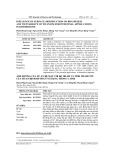

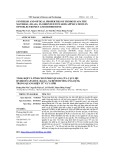


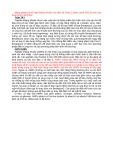





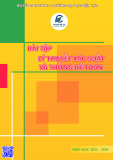






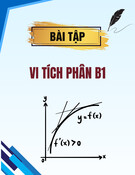



![Quyển ghi Xác suất và Thống kê [chuẩn nhất]](https://cdn.tailieu.vn/images/document/thumbnail/2025/20251030/anh26012006/135x160/68811762164229.jpg)
